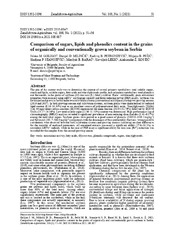Приказ основних података о документу
Comparison of sugars, lipids and phenolics content in the grains of organically and conventionally grown soybean in Serbia
| dc.creator | Golijan, Jelena M. | |
| dc.creator | Milinčić, Danijel D. | |
| dc.creator | Petronijević, Radivoj B. | |
| dc.creator | Pešić, Mirjana B. | |
| dc.creator | Stanojević, Sladjana P. | |
| dc.creator | Barać, Miroljub B. | |
| dc.creator | Lekić, Slavoljub | |
| dc.creator | Kostić, Aleksandar Ž. | |
| dc.date.accessioned | 2021-03-10T15:43:02Z | |
| dc.date.available | 2021-03-10T15:43:02Z | |
| dc.date.issued | 2021 | |
| dc.identifier.issn | 1392-3196 | |
| dc.identifier.uri | http://aspace.agrif.bg.ac.rs/handle/123456789/5817 | |
| dc.description.abstract | The aim of the current study was to determine the content of several primary metabolites: total soluble sugars, starch and lipids, soluble sugars, fatty acids and triacylglycerols profile, and secondary metabolites: total phenolics and flavonoids, in the grains of soybean (Glycine max (L.) Merr.) cultivar ‘Kaća’. Additionally, grain antioxidant properties were assessed using ABTS•+ scavenging capacity and ferric reducing power (FRP) assays. Soybean was developed and grown in Serbia under two cultivation systems (conventional and organic) during two growing seasons (2016 and 2017). In both growing seasons and cultivation systems, soybean grains were characterised by reduced lipid content (8.16–14.34%) and as an excellent source of polyunsaturated fatty acids. Triacylglycerols (TAGs) with 44 equivalent carbon numbers (ECN44) represented the main fraction (30.95–32.79%) followed by ECN46 TAGs (23.27–26.36%). Low total soluble sugars (2.36–11.51%) content was determined. High-performance liquid chromatography (HPLC) analysis revealed a significant prevalence of non-reducing disaccharides (1.41–6.57%) among the individual sugars. Soybean grains were proved as a good source of phenolic (2493.9–4419.5 mg kg-1) and flavonoid (292.7–500.9 mg kg-1) compounds with the dominance of free (extractable) fractions. Strong positive correlations were observed between both cultivation systems and growing seasons indicating no clear differences for the majority of analysed parameters. All examined extracts possessed a significant ability (27.6–38.2%) to neutralize ABTS•+ radicals, while in the case of FRP assay a significant ability for iron ions (Fe3+) reduction was recorded for the samples from the second growing season. | sr |
| dc.language.iso | en | sr |
| dc.publisher | Lithuanian Research Centre for Agriculture and Forestry; Vytautas Magnus University | sr |
| dc.relation | info:eu-repo/grantAgreement/MESTD/inst-2020/200116/RS// | sr |
| dc.rights | openAccess | sr |
| dc.rights.uri | https://creativecommons.org/licenses/by/4.0/ | |
| dc.source | Zemdirbyste | sr |
| dc.subject | Antioxidant activity | sr |
| dc.subject | Fatty acids | sr |
| dc.subject | Glycine max | sr |
| dc.subject | Phenolic compounds | sr |
| dc.subject | Sugars | sr |
| dc.subject | Triacylglycerols | sr |
| dc.title | Comparison of sugars, lipids and phenolics content in the grains of organically and conventionally grown soybean in Serbia | sr |
| dc.type | article | sr |
| dc.rights.license | BY | sr |
| dc.citation.epage | 56 | |
| dc.citation.issue | 1 | |
| dc.citation.rank | M23 | |
| dc.citation.spage | 51 | |
| dc.citation.volume | 108 | |
| dc.identifier.doi | 10.13080/z-a.2021.108.007 | |
| dc.identifier.fulltext | http://aspace.agrif.bg.ac.rs/bitstream/id/22902/Comparison_of_sugars_pub_2021.pdf | |
| dc.identifier.scopus | 2-s2.0-85101197268 | |
| dc.identifier.wos | 000615356300007 | |
| dc.type.version | publishedVersion | sr |


